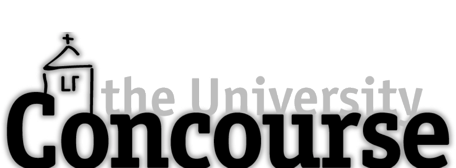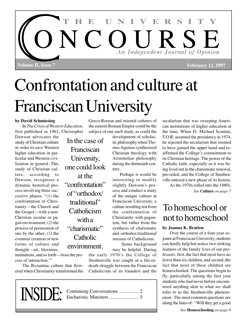Confrontation and culture at Franciscan University
by David Schmiesing
In The Crisis of Western Education, first published in 1961, Christopher Dawson advocates the study of Christian culture in order to save Western higher education in particular and Western civilization in general. This study of Christian culture, according to Dawson, recognizes a dynamic historical process involving three successive phases: “(1) the confrontation of Christianity—the Church and the Gospel—with a non-Christian secular or pagan environment; (2) the process of permeation of one by the other; (3) the eventual creation of new forms of culture and thought—art, literature, institutions, and so forth—from the process of interaction.”1
The Byzantine culture that flowered when Christianity transformed the Greco-Roman and oriental cultures of the eastern Roman Empire could be the subject of one such study, as could the development of scholastic philosophy when Thomas Aquinas synthesized Christian theology with Aristotelian philosophy during the thirteenth century.
Perhaps it would be interesting to modify slightly Dawson’s process and conduct a study of the unique culture at Franciscan University, a culture resulting not from the confrontation of Christianity with paganism, but rather from the synthesis of charismatic and orthodox/traditional streams of Catholicism.
Some background may be helpful. During the early 1970’s the College of Steubenville was caught in a life-or-death struggle between the Franciscan Catholicism of its founders and the secularism that was sweeping American institutions of higher education at the time. When Fr. Michael Scanlan, T.O.R. assumed the presidency in 1974, he rejected the secularism that seemed to have gained the upper hand and re-affirmed the College’s commitment to its Christian heritage. The power of the Catholic faith, especially as it was being lived out in the charismatic renewal, prevailed, and the College of Steubenville entered a new phase of its history.
As the 1970s rolled into the 1980s, the College became the University. Under the leadership of Fr. Michael and others, it grew in its reputation as a center of Catholic charismatic renewal, but also as a liberal arts institution of higher education that proclaimed faithfulness to Jesus Christ and to the Magisterium of the Catholic Church. This would not have been so noteworthy, except for the fact that it happened at a time when most other Catholic colleges and universities were downplaying or even denying their religious identity. So, another phase of the University’s history began as students, staff and faculty who had little familiarity with (and sometimes even hostility toward) the charismatic renewal were attracted by the University’s commitment to orthodox Catholic teaching.
The first step in Dawson’s study of Christian culture looks at the confrontation of Christianity with a pagan environment. In the case of Franciscan University, one could look at the “confrontation” of “orthodox/traditional” Catholicism with a “charismatic” Catholic environment.
As far as the University and this article are concerned, “charismatic” Catholicism refers to the spirituality that is generally marked by emphases on the gifts and power of the Holy Spirit, evangelism, a personal relationship with Jesus Christ, and joyful, communal, emotional worship and liturgy. “Traditional” Catholicism stresses more the intellectual understanding of the Faith, private devotion and contemplative worship, and fidelity to the Pope and the Magisterium. These distinctions are only rough sketches of the charismatic and traditional spiritualities and they refer not to absolutes, but rather to emphases. These distinctions are not meant to imply that charismatics are not faithful to the Pope or that traditionalists do not believe in the Holy Spirit. But, they serve to illustrate the two streams that have been in tension with each other at the University for over a decade.
Some may argue that using labels such as “orthodox/traditional” and “charismatic” only serve to polarize and divide, and that the University family needs to move beyond these differences. While this could be true in certain individual cases, it seems more accurate to view the traditional/charismatic tension as a healthy interaction between two legitimate streams of Catholicism, each permeating the other (the second step in Dawson’s process). The result, “new forms of culture and thought,” is Dawson’s third step. This new culture is not just the peaceful co-existence of the two elements, but is an entirely new entity with a life of its own.
Could it be that the University is the environment of a new Catholic culture: a vibrant, exciting and vital culture that is not simply charismatic or traditional, but charismatic and traditional? Is it possible that, by bringing “charismatic” Catholicism together with “traditional” Catholicism in a liberal arts institution of higher education, Fr. Michael has provided the ingredients and the setting for a new Christian culture that is flourishing in the Ohio Valley? Rather than struggling with each other for domination, simply tolerating each other, or just “learning from each other,” have the two afore-mentioned streams of Catholic spirituality actually fallen in love, married and produced a beautiful child? Is it possible that the whole is greater than the sum of the parts?
While the long-term effects of this unique “Steubenville culture” will become evident only with time, it does seem clear that the students, staff and faculty of Franciscan University really are witnessing a cultural birth and infancy. This culture is marked by unashamed loyalty to the Pope and the Magisterium, and the realization that the Church’s ability to articulate doctrine does evolve over time. It is marked by a joyful, exuberant, emotional faith that seeks grounding in intellectual understanding. It reveres and practices and promulgates the traditions and devotions of the past, and is also open to the movements of the Holy Spirit now and in the future. It stresses the importance both of a personal relationship with Jesus Christ, and of a personal relationship with His Body, the Church. It is comfortable with praising the Trinity in strange tongues, whether it be Latin or otherwise. It is truly orthodox, but dynamically and vitally so. It worships together out loud in the open, and quietly, alone with the Lord.
The tensions that brought about its birth continue to feed its growth and maturation, although sometimes this is a painful and difficult process. This “Steubenville culture” could not have happened without both the “charismatic” and the “traditional” components. Each part balances and complements the other. If one “side” ever calls it quits and concedes defeat, the growth will stop. Creativity will no longer be necessary. And once stagnation sets in, decline will begin. The struggle is the source of vitality, provided it is a struggle marked by charity, patience, prudence and humility.
There are many other charismatic Catholic groups, and many other traditional Catholic organizations. But there is no other place that brings full-blown versions of both together into a university setting, a setting that has the luxury of working out the ramifications of both streams on its own faith and intellectual life, and then transmitting the resulting new culture to others.
One could make the case that the application of Dawson’s second step is even now premature. Perhaps a third force is being added to the picture that is just as important and dynamic and vital as the charismatic and traditional influences: the effects of the Austrian program. In Austria, students, faculty and staff are able to witness firsthand a culture that was, until recently, thoroughly Catholic. They discover the historical roots and the universality of Catholicism by traveling across the continent and living with eastern Europeans. And they are able to live, pray and study in a close-knit intellectual and faith community (university) where they can bring all of this to bear upon the unique Steubenville culture they carried with them from America. It is important to note that if the Austrian program were acting upon a university that was only charismatic or only traditional, or even upon an entity that was both, but not a university, the results would not be as powerful. In fact, we may not notice any results at all.
Therefore, people of Franciscan University, do not bemoan the tension between charismatics and orthodox traditionalists. Do not attempt to quash, appease or excuse one or the other in the hope of achieving peace and unity. Rather, rejoice in the legitimate differences and the unique phenomenon that is taking place on a hilltop in the Ohio Valley. Delight in the fact that charismatic and traditional Catholicism is able to interact in a university setting, a tale that can be told of no other place in the world. After all, not everyone gets to see a culture being born.
David Schmiesing, who with his wife, Justine, is Design Editor for the Concourse, graduated from FUS in 1992.
- The Crisis of Western Education, (Steubenville, OH: Franciscan University Press, 1989) 164. ↑


